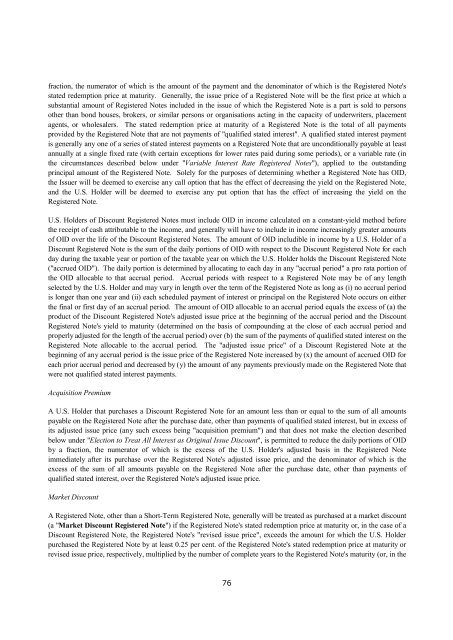JPMORGAN CHASE & CO. - Irish Stock Exchange
JPMORGAN CHASE & CO. - Irish Stock Exchange
JPMORGAN CHASE & CO. - Irish Stock Exchange
Create successful ePaper yourself
Turn your PDF publications into a flip-book with our unique Google optimized e-Paper software.
fraction, the numerator of which is the amount of the payment and the denominator of which is the Registered Note's<br />
stated redemption price at maturity. Generally, the issue price of a Registered Note will be the first price at which a<br />
substantial amount of Registered Notes included in the issue of which the Registered Note is a part is sold to persons<br />
other than bond houses, brokers, or similar persons or organisations acting in the capacity of underwriters, placement<br />
agents, or wholesalers. The stated redemption price at maturity of a Registered Note is the total of all payments<br />
provided by the Registered Note that are not payments of "qualified stated interest". A qualified stated interest payment<br />
is generally any one of a series of stated interest payments on a Registered Note that are unconditionally payable at least<br />
annually at a single fixed rate (with certain exceptions for lower rates paid during some periods), or a variable rate (in<br />
the circumstances described below under "Variable Interest Rate Registered Notes"), applied to the outstanding<br />
principal amount of the Registered Note. Solely for the purposes of determining whether a Registered Note has OID,<br />
the Issuer will be deemed to exercise any call option that has the effect of decreasing the yield on the Registered Note,<br />
and the U.S. Holder will be deemed to exercise any put option that has the effect of increasing the yield on the<br />
Registered Note.<br />
U.S. Holders of Discount Registered Notes must include OID in income calculated on a constant-yield method before<br />
the receipt of cash attributable to the income, and generally will have to include in income increasingly greater amounts<br />
of OID over the life of the Discount Registered Notes. The amount of OID includible in income by a U.S. Holder of a<br />
Discount Registered Note is the sum of the daily portions of OID with respect to the Discount Registered Note for each<br />
day during the taxable year or portion of the taxable year on which the U.S. Holder holds the Discount Registered Note<br />
("accrued OID"). The daily portion is determined by allocating to each day in any "accrual period" a pro rata portion of<br />
the OID allocable to that accrual period. Accrual periods with respect to a Registered Note may be of any length<br />
selected by the U.S. Holder and may vary in length over the term of the Registered Note as long as (i) no accrual period<br />
is longer than one year and (ii) each scheduled payment of interest or principal on the Registered Note occurs on either<br />
the final or first day of an accrual period. The amount of OID allocable to an accrual period equals the excess of (a) the<br />
product of the Discount Registered Note's adjusted issue price at the beginning of the accrual period and the Discount<br />
Registered Note's yield to maturity (determined on the basis of compounding at the close of each accrual period and<br />
properly adjusted for the length of the accrual period) over (b) the sum of the payments of qualified stated interest on the<br />
Registered Note allocable to the accrual period. The "adjusted issue price" of a Discount Registered Note at the<br />
beginning of any accrual period is the issue price of the Registered Note increased by (x) the amount of accrued OID for<br />
each prior accrual period and decreased by (y) the amount of any payments previously made on the Registered Note that<br />
were not qualified stated interest payments.<br />
Acquisition Premium<br />
A U.S. Holder that purchases a Discount Registered Note for an amount less than or equal to the sum of all amounts<br />
payable on the Registered Note after the purchase date, other than payments of qualified stated interest, but in excess of<br />
its adjusted issue price (any such excess being "acquisition premium") and that does not make the election described<br />
below under "Election to Treat All Interest as Original Issue Discount", is permitted to reduce the daily portions of OID<br />
by a fraction, the numerator of which is the excess of the U.S. Holder's adjusted basis in the Registered Note<br />
immediately after its purchase over the Registered Note's adjusted issue price, and the denominator of which is the<br />
excess of the sum of all amounts payable on the Registered Note after the purchase date, other than payments of<br />
qualified stated interest, over the Registered Note's adjusted issue price.<br />
Market Discount<br />
A Registered Note, other than a Short-Term Registered Note, generally will be treated as purchased at a market discount<br />
(a "Market Discount Registered Note") if the Registered Note's stated redemption price at maturity or, in the case of a<br />
Discount Registered Note, the Registered Note's "revised issue price", exceeds the amount for which the U.S. Holder<br />
purchased the Registered Note by at least 0.25 per cent. of the Registered Note's stated redemption price at maturity or<br />
revised issue price, respectively, multiplied by the number of complete years to the Registered Note's maturity (or, in the<br />
76
















